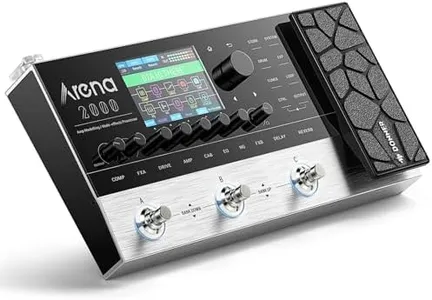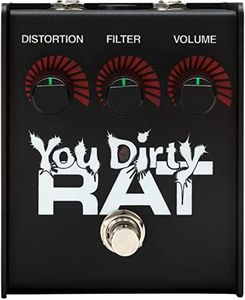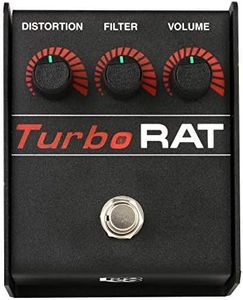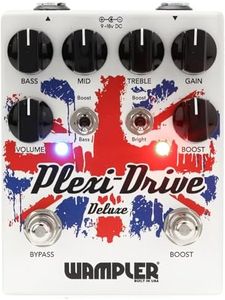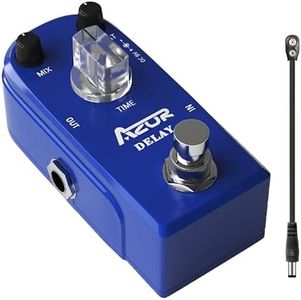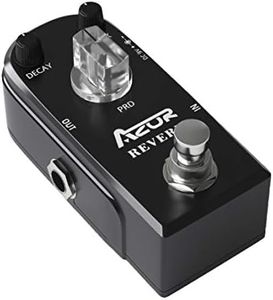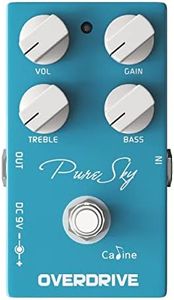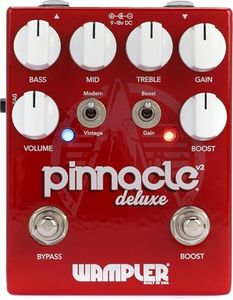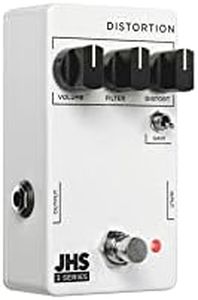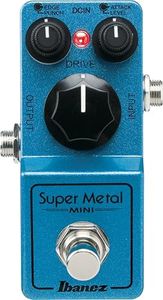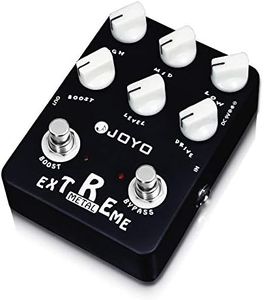10 Best Distortion Pedals 2025 in the United States
Our technology thoroughly searches through the online shopping world, reviewing hundreds of sites. We then process and analyze this information, updating in real-time to bring you the latest top-rated products. This way, you always get the best and most current options available.

Our Top Picks
Winner
Donner Distortion Guitar Pedal, Morpher Mini Distortion 3 Modes Natural, Tight, Classic Crunch 80s Metal for Electric Guitar True Bypass
Most important from
21568 reviews
The Donner Morpher Mini Distortion pedal is a solid choice if you’re looking for a versatile distortion effect, especially for styles like hair metal or glam rock. It offers three different distortion modes—Natural, Tight, and Classic Crunch—which gives you a nice range of tones from smooth to gritty, making it suitable for both lead guitar solos and riff-heavy playing. The pedal provides high-gain distortion that can deliver a rich sound without getting too muddy, and the true bypass design ensures your guitar's original tone stays clear when the pedal is off, avoiding unwanted noise or signal loss.
In terms of build, this pedal feels sturdy with its full aluminum-alloy casing, which is great for regular gigging or practice. It’s also compact and lightweight, so it won’t take up much space on your pedalboard or in your bag. However, one drawback is that it doesn’t come with a power supply, so you’ll need to buy a 9V DC adapter separately (make sure it’s center negative and provides at least 500mA).
If you want a distortion pedal that covers a good range of high-gain tones and provides reliable true bypass functionality, the Morpher Mini is a nice option. Just keep in mind you’ll have to arrange for power yourself and that the pedal leans towards rock and metal genres rather than blues or softer tones.
Most important from
21568 reviews
BOSS DS-1X Distortion | Advanced Guitar Effect Pedal Powered by MDP Technology | High-Def Distortion for Modern Players from Crunch to Mega-Gain | Powerful Real-Time Processing | 5-Year Warranty
Most important from
4711 reviews
The BOSS DS-1X distortion pedal is designed for guitar players looking for a versatile and modern distortion effect. It uses advanced Multi-Dimensional Processing technology, which adapts well to different playing styles and notes across the fretboard, from tight, crisp lows to clear, singing highs. This provides a high-definition distortion sound that stays clean and never becomes muddy, even at high gain settings. The pedal offers a wide range of tone shaping through its Drive, High, and Low knobs, making it easy to dial in sounds from crunchy to mega-gain distortion. It responds well to your guitar’s volume and picking dynamics, adding expression to your playing.
In terms of build, the DS-1X has a sturdy metal body typical of BOSS pedals, ensuring it can handle regular use. It runs on standard 9-volt power via a corded electric supply and includes a 1 AAA battery for convenience. The pedal uses buffered bypass to maintain signal integrity, which can be important depending on your setup. It is compact and lightweight, making it easy to fit on pedalboards.
Although the DS-1X delivers very low noise even at high gain, the use of buffered bypass rather than true bypass may influence tone when the pedal is off. For those who want a reliable and high-quality distortion pedal with modern features and extensive tone control, the DS-1X is a strong choice, especially backed by a 5-year warranty. It suits guitarists seeking clear, dynamic distortion that performs well across different styles and settings.
Most important from
4711 reviews
Pro Co You Dirty Rat Distortion Pedal
Most important from
2112 reviews
The Pro Co You Dirty Rat Distortion Pedal is a solid choice for players looking for an authentic analog distortion with a gritty, vintage vibe. Its 100% analog signal path ensures a warm and natural tone that many guitarists love. This pedal delivers a raw, aggressive distortion that works well for blues, rock, and punk styles rather than high-gain metal sounds. The tone control allows you to shape your sound effectively, giving you some flexibility without complexity.
Build quality is a major highlight — the pedal features a tough steel enclosure and heavy-duty footswitches and knobs, making it highly durable for frequent use on stage or in the studio. It runs on a 9-volt battery, which is convenient but requires having batteries handy or using a compatible power supply. This pedal suits musicians who want a reliable, straightforward distortion with classic character and rugged build, but if you seek ultra-high gain or digital versatility, exploring other options may be preferable.
Most important from
2112 reviews
Buying Guide for the Best Distortion Pedals
Choosing the right distortion pedal can significantly impact your guitar's sound and overall performance. Distortion pedals are used to add grit, sustain, and character to your guitar tone, making them a crucial part of any guitarist's setup. To find the best fit for you, it's important to understand the key specifications and how they align with your playing style and musical preferences.FAQ
Most Popular Categories Right Now
